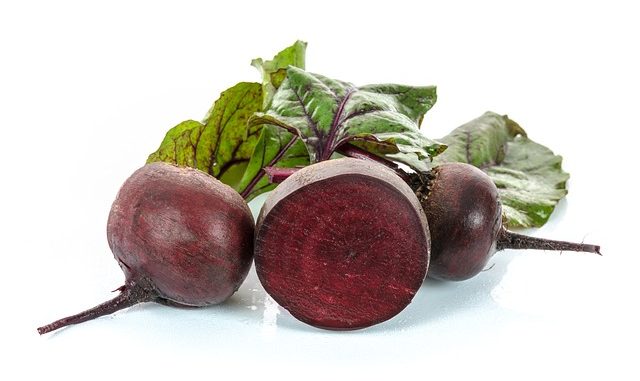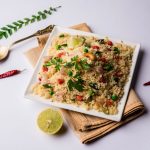
Betalains are a naturally occurring class of orange-red pigments which make excellent food colouring for snacks in particular. The pigment range includes red-violet betacyanins and yellow betaxanthins. They are heat stable and show antioxidant activity over a wide pH range (pH 3 to 7). Of all the colouring compounds the betalains are excellent complements to the anthocyanins.
The main plant family producing betalains are the Caryophyllales and use this pigment instead of anthocyanins. There are some members of the cactus family and the Amaranths which contain the pigment too (Stintzing et al., 2001). The compounds also found in fungi but only in a few members of the Basidiomycetes. Unlike the anthocyanins, betalains are found in all sorts of plant structures including not just the fruits and leaves but the roots, stems and petals. Beetroot is probably the best example of a food or vegetable which is coloured by these pigments.
From a product development point of view, they are more stable at less acidic pHs than anthocyanins. They are ideal as colouring agents for low-acid and neutral foods. Dairy products seem especially popular where colouring with anthocyanins certainly fail (Stintzing and Carle, 2004). It is very common to see them on the ingredient list in snack foods and in some cases beverages but it is the solid product which is prepared by heating that benefits most from the use of betalains.
Sources
Beetroot, pitaya fruit, (Prickly Pear cactus) Opuntia ficus-indica
The name betalain comes from the latin word for the common beetroot which is Beta vulgaris. They were first extracted from this vegetable. Based on dry matter amounts, about 1% of beetroot consists of betalains (Mégard 1993).
Structure
A series of nitrogen-containing indoles. In structure these are often termed as the water-soluble immonium conjugates of betalamic acid with cyclo-Dopa (betacyanins, red-violet), and amino acids or amines (betaxanthins, yellow), respectively (Strack et al., 2003). So there are two basic types:-
Betacyanins which are present as red to violet pigments. The specific types include betanin, isobetanin, probetanin and neobetanin.
Betaxanthins are yellow-orange pigments. Specific pigments include miraxanthin, portulaxanthin, vulgaxanthin and indicaxanthin.
There is a thought they are fungicidal but they also fluoresce which indicates they might serve as colour lures for insects such as bees attracting them to the flower.
Stability
Betalains are stabilised by a high degree of glucosylation and acylation. It also stabilised in products with a low water activity and by various other ingredients which form part of the food matrix. In beverages, betalains tend to breakdown all too easily. Metal cations are destabilising so chelating agents are positive factors in betalain stability. Likewise, oxygen free and low temperatures are natural stabilising factors. The temperatures for processing above 50 °C might be the most challenging (Havilova et al., 1983).
The pH is important. Beyond the pH 3 to 7, the betalains break down. The optimum pH is between pH 4 and 6 (Havilova et al., 1983).
In alkaline conditions betalain degradation takes many forms.
Crude enzyme preparations taken from beetroot will also decolourise betaxanthines and betacyanines. Enzymes which degrade betalains are also found in commercial enzyme preparations without it being assayed for which implies they are unknown about in many cases.
Cocrystallization is an effective way to prevent colour breakdown. Blends with sucrose and sucrose + maltodextrin are particularly useful (Jimenez, 2010).
In terms of betalain stability to temperature, they are highly unstable and this probably their greatest drawback. Both betanin and vulgaxanthin-I follow first order degradation kinetics over a pH range of 3 to 7 in the presence of oxygen.
Health Benefits
Betalains are claimed to provide protection against stress-related disorders. They have the potential along with anthocyanins for inhibiting lipid oxidation and peroxidation (Kanner et al., 2001). They are said to have anti-inflammatory benefits with both antioxidative and antiradical activity (Gentile et al., 2004). One study shows that betalain has a better antioxidant activity than Trolox (Stintzing et al., 2005).
References
Cai, Y., Sun, M., Corke, H. (2005) Characterization and application of betalain pigments from plants of the Amaranthaceae. Trends Food Sci. Technol. 16 pp. 370–6. (Article)
Gentile, C., Tesoriere, L., Allegra, M., Livrea, M.A., D’Alessio, P. (2004) Antioxidant betalains from cactus pear (Opuntia ficus‐indica) inhibit endothelial ICAM‐1 expression. Ann N Y Acad Sci 1028 pp. 481–6. (Article)
Havlíková L, Míková K, Kyzlink V. (1983) Heat stability of betacyanins. Z Lebensm Unters Forsch 177 pp. 247–50. (Article)
Jimenez, M. (2010) Physicochemical properties of entrapped betalains using sucrose and a blend with sucrose:maltodextrin by co-crystallization. Abstract 2010 IFT Annual Mtg. July 17-20, Chicago. Il. USA
Kanner J, Harel S, Granit R. (2001) Betalains—A new class of dietary cationized antioxidants. J Agric Food Chem 49 pp. 5178–85. (Article)
Mégard, D. (1993) Stability of red beet pigments for use as food colorant: a review. Foods Food Ingred. J. 158 pp. 130–50.
Stintzing, F.C., Carle, R. (2004) Functional properties of anthocyanins and betalains in plants, food, and in human nutrition. Trends Food Sci. Technol. 15 pp. 19–38. (Article)
Stintzing FC, Herbach KM, Moßhammer MR, Carle R, Yi W, Sellappan S, Akoh CC, Bunch R, Felker P. (2005) Color, betalain pattern, and antioxidant properties of cactus pear (Opuntia ssp.) clones. J Agric Food Chem 53 pp. 442–51. (Article)


Leave a Reply